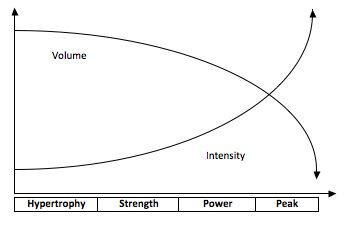Many times we see people starting to implement weight training into their weekly routines. In most of these cases however, the program itself isn’t fully structured. It’s easy for all of us to get caught up in the normal routine of just coming to the gym and training a body part. We don’t always take in to consideration things such as….
- Exercise Selection (many times it is random)
- Intensity Measures
- Volume
- Frequency
- Duration
- Etc…
It is however understandable for the beginner to keep things simple. Trying to overwhelm yourself with too much depth may simply lead to falling off. So how can you take some basic periodization principles and implement them into your daily workouts?
WHAT IS PERIODIZATION
First we need to understand what periodization is. Periodization simply refers to the planned structure of a workout routine. We are basically separating different training methods into “periods”. For instance, you would spend a period of time working on muscular endurance and getting adapted to an exercise mode, and then transition into a strength period.
The idea is that you will take the positive adaptations from each section and carry them on to the next. This also helps us to assure we are “overloading” aka training at a stress the body is not accustom. By overloading we are pushing our body into positive adaptation. That could be strength, endurance, balance, muscle growth, etc…
NON LINEAR PERIODIZATION
Non linear periodization is generally a periodized workout that is broken down into high intensity, low volume followed by high volume, lower intensity sections. This can be within the same week or broken down into week blocks.
Example:
Monday | Tuesday | Wednesday: 5 sets x 10 reps (higher volume, but lesser Intensity)
Thursday | Friday | Saturday: 5 sets x 5 reps (higher intensity, but lesser volume)
Or
Week 1: 5 sets x 10 reps (higher volume, but lesser Intensity)
Week 2: 5 sets x 5 reps (higher intensity, but lesser volume)
Non linear periodization has shown to be effective in keeping up with positive progress in athletes. If you are noticing a plateau in your results, implementing a non linear periodization structure may help get you to the next level of progress.
Below is a FREE example of a non linear periodization program for you to implement into your weight training program.
MONDAY – PUSH / LOW VOLUME / HIGH INTENSITY
Ex 1: Bench Press 10 sets x 5 reps
Ex 2: Standing Overhead Press 10 sets x 5 reps
TUESDAY- PULL / LOW VOLUME / HIGH INTENSITY
Ex 1: Dead Lift 10 sets x 5 reps
Ex 2: Bent Over Barbell Row 10 sets x 5 reps
WEDNESDAY – LEGS / LOW VOLUME / HIGH INTENSITY
Ex 1: Squat 10 sets x 5 reps
THURSDAY- PUSH / HIGH VOLUME / LOW INTENSITY
Ex 1: Dumbbell Bench Press 3 sets x 12 reps
Ex 2: Machine Chest Fly 3 sets x 12 reps
Ex 3: Push-Ups 3 sets x 20 reps
Ex 4: Seated Dumbbell Shoulder Press 3 sets x 12 reps
Ex 5: Dumbbell Lateral Raise 3 sets x 12 reps
FRIDAY- PULL / HIGH VOLUME / LOW INTENSITY
Ex 1: Wide Grip Lat Pull-Down 3 sets x 12 reps
Ex 2: Seated Row 3 sets x 12 reps
Ex 3: One Arm Dumbbell Row 3 sets x 12 reps
Ex 4: Bent Dumbbell Flys 3 sets x 12 reps
Ex 5: Reverse Chest Fly Machine 3 sets x 12 reps
SATURDAY – LEGS / HIGH VOLUME / LOW INTENSITY
Ex 1: Leg Press 3 sets x 12 reps
Ex 2: Lunges 3 sets x 12 reps
Ex 3: Leg Extensions 3 sets x 12 reps
Ex 4: Lying Leg Curls 3 sets x 12 reps
Ex 5: Standing Calf Raise 3 sets x 20 reps
SUNDAY – REST
Like us on Facebook – http://Facebook.com/TheFitnessTrainerAcademy
Follow Us On Instagram – http://Instagram.com/FTA_FitnessTrainerAcademy
Visit Our Website – http://TheFitnessTrainerAcademy.org

